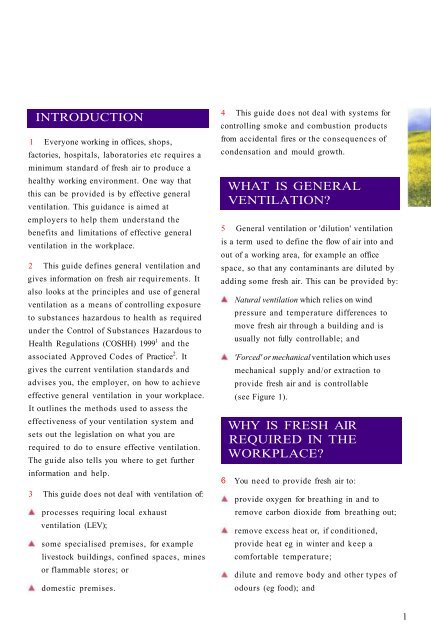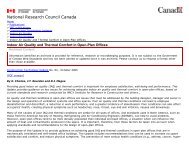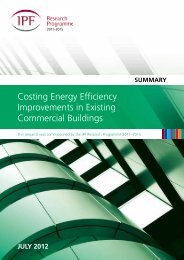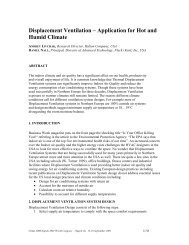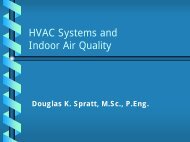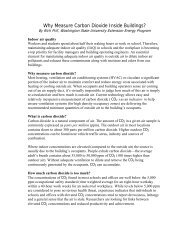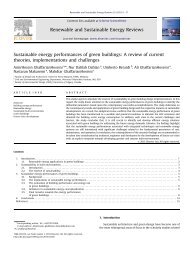General Ventilation in the Workplace Guidance for Employers
General Ventilation in the Workplace Guidance for Employers
General Ventilation in the Workplace Guidance for Employers
- No tags were found...
Create successful ePaper yourself
Turn your PDF publications into a flip-book with our unique Google optimized e-Paper software.
INTRODUCTION1 Everyone work<strong>in</strong>g <strong>in</strong> offices, shops,factories, hospitals, laboratories etc requires am<strong>in</strong>imum standard of fresh air to produce ahealthy work<strong>in</strong>g environment. One way thatthis can be provided is by effective generalventilation. This guidance is aimed atemployers to help <strong>the</strong>m understand <strong>the</strong>benefits and limitations of effective generalventilation <strong>in</strong> <strong>the</strong> workplace.2 This guide def<strong>in</strong>es general ventilation andgives <strong>in</strong><strong>for</strong>mation on fresh air requirements. Italso looks at <strong>the</strong> pr<strong>in</strong>ciples and use of generalventilation as a means of controll<strong>in</strong>g exposureto substances hazardous to health as requiredunder <strong>the</strong> Control of Substances Hazardous toHealth Regulations (COSHH) 1999 1 and <strong>the</strong>associated Approved Codes of Practice 2 . Itgives <strong>the</strong> current ventilation standards andadvises you, <strong>the</strong> employer, on how to achieveeffective general ventilation <strong>in</strong> your workplace.It outl<strong>in</strong>es <strong>the</strong> methods used to assess <strong>the</strong>effectiveness of your ventilation system andsets out <strong>the</strong> legislation on what you arerequired to do to ensure effective ventilation.The guide also tells you where to get fur<strong>the</strong>r<strong>in</strong><strong>for</strong>mation and help.3 This guide does not deal with ventilation of:processes requir<strong>in</strong>g local exhaustventilation (LEV);some specialised premises, <strong>for</strong> examplelivestock build<strong>in</strong>gs, conf<strong>in</strong>ed spaces, m<strong>in</strong>esor flammable stores; ordomestic premises.4 This guide does not deal with systems <strong>for</strong>controll<strong>in</strong>g smoke and combustion productsfrom accidental fires or <strong>the</strong> consequences ofcondensation and mould growth.WHAT IS GENERALVENTILATION?5 <strong>General</strong> ventilation or 'dilution' ventilationis a term used to def<strong>in</strong>e <strong>the</strong> flow of air <strong>in</strong>to andout of a work<strong>in</strong>g area, <strong>for</strong> example an officespace, so that any contam<strong>in</strong>ants are diluted byadd<strong>in</strong>g some fresh air. This can be provided by:6Natural ventilation which relies on w<strong>in</strong>dpressure and temperature differences tomove fresh air through a build<strong>in</strong>g and isusually not fully controllable; and'Forced' or mechanical ventilation which usesmechanical supply and/or extraction toprovide fresh air and is controllable(see Figure 1).WHY IS FRESH AIRREQUIRED IN THEWORKPLACE?You need to provide fresh air to:provide oxygen <strong>for</strong> breath<strong>in</strong>g <strong>in</strong> and toremove carbon dioxide from breath<strong>in</strong>g out;remove excess heat or, if conditioned,provide heat eg <strong>in</strong> w<strong>in</strong>ter and keep acom<strong>for</strong>table temperature;dilute and remove body and o<strong>the</strong>r types ofodours (eg food); and1


